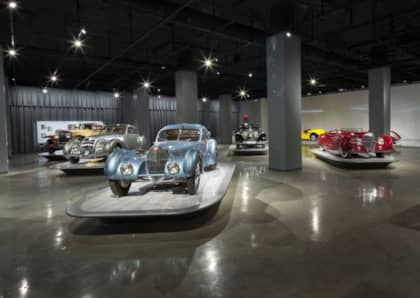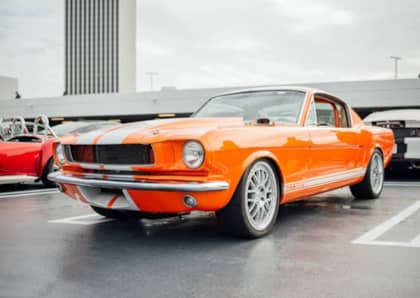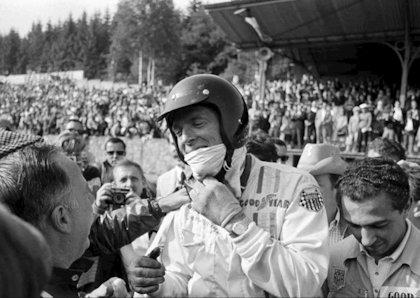All American Hero: The Petersen Pays Tribute to Dan Gurney & AAR
The year was 1967, and what a year it was for a young Southern Californian man by the name of Dan Gurney. By the mid '60s, Gurney had already established himself as one of America's most successful race car drivers and builders; his list of accomplishments in 1967 alone is enough to rival the entire careers of many legendary drivers.

1967 was the year that saw Gurney compete in over 27 different major motorsport events in several different disciplines. The man basically raced anything with wheels. His accomplishments that year include winning the 24 Hours of Le Mans in a Ford GT40 Mark IV he co-drove with AJ Foyt, starting on the front row of the Indianapolis 500 in his Indy Eagle — driving everything from a Mercury Cougar Trans Am car to a Can Am Lola T70. If that wasn't enough, he also competed in Formula 1, and in June 1967 at the Belgian Grand Prix, he made history when he became the only American ever to win a Grand Prix while driving a car of his own construction.

To mark the 50th anniversary of that historic racing season, the Petersen Automotive Museum is holding a special exhibition that celebrates the career and accomplishments of Gurney and the All American Racers. During the recent Japanese Cruise-In at the Petersen, I made some time to go in and take a look.

Making the exhibit even very appropriate for the Petersen is the fact that Gurney began his racing exploits in Southern California, building hot rods as a young man before moving to sanctioned motorsport. He also established the Orange County city of Santa Ana as the base of operations for his legendary All American Racers (AAR) team operations.

Gurney founded AAR with Carroll Shelby in 1965, and the company would go on designing and building race for decades after Gurney retired from driving. Under the guidance of Gurney and his son Justin, the company continues operations to this day, most recently developing the Delta Wing race car and is also heavily involved in aerospace engineering.

The Petersen exhibit chronicles Gurney's story as both a driver and builder. It includes several different race cars that he and AAR designed from the 1960s right through to the 1990s, as well as plenty of important artifacts from his career.
Among the memorabilia on display is the bottle of champagne that he was given on the podium after winning the 24 Hours of Le Mans in 1967. After he received the bottle, he shook it up and sprayed its contents on to all who'd gathered around — unwittingly starting a celebratory tradition that many race winners still do today.

Just a few months later, it was in this Eagle Gurney-Weslake V12 Formula 1 car where he made history at the Belgian Grand Prix. With a lightweight chassis that used both titanium and magnesium, the car made 400 horsepower and had a top speed of 196 miles per hour.

Gurney and AAR also have a long history with Indy cars like this '68 AAR Olsonite Eagle, which won at Riverside and finished second in the 1968 Indianapolis 500 behind Bobby Unser's race-winning Rislone Eagle.

Along with open wheel race cars, Dan Gurney also saw plenty of action in both sports cars and NASCAR stock cars during the '60s. This is the AAR-prepared Plymouth Barracuda that he drove during the 1970 SCCA Trans Am season, which included his final championship race as professional driver at Riverside — although he did make a one-race return to NASCAR at Riverside in 1980.

This particular car was eventually sold to Chrysler France, where it was used in various events including the 24 Hours of Le Mans before returning to the U.S. and being restored in the '90s. This is also the car inspired by the rare 1970 AAR 'Cuda street car that's heavily sought after by collectors today.

The AAR story continued long after Gurney put away his racing helmet, and the display also includes historic AAR Eagle machines like this pair of Indy Eagles from 1971 and 1975.

Among Gurney's contributions to the engineering world is the famous "Gurney Flap," a perpendicular tab across the edge of a spoiler which improves downforce. It was an innovation that wasn't just used in motorsports but in aircraft as well.

He first began experimenting with the flap on this 1971 Olsonite Eagle during a test session at Phoenix International Raceway. A few years earlier Gurney also pioneered the now-standard full face race helmet during the '68 Formula 1 season.

When asked what his favorite AAR Eagle race car is, Gurney points to this car: the 1981 Indy Eagle Pepsi Challenger. With an innovative downforce-creating Boundary Layer Adhesion Technology developed by AAR, the Pepsi Challenger achieved great success during the '81 season before rule changes banned its design the following year.

During the '80s and '90s, AAR enjoyed a close relationship with Toyota. The result was several dominant cars, including this 1993 AAR-Toyota Eagle MK III GTP car that led the GTP field with an incredible 17 consecutive victories.

This Toyota-powered 1999 AAR Eagle 997 Champ Car was the last of the production Eagles built by AAR, wrapping up decades of success in fiercely competitive Indy racing.

Whether behind the wheel, inside the garage or in the wind tunnel, the contributions of Dan Gurney and the All American Racers to American motorsport history will not be matched anytime soon. If you have the chance, I highly recommend getting down to the Petersen to check out the exhibit before its too late.












